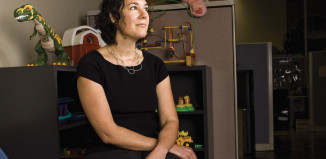It was 1962 when H.W. Janson first published his “History of Art.” Widely used for decades as the principal textbook in collegiate art history, the book painstakingly documented artwork from the time of early cavemen through the pop-art era of Andy Warhol. There was just one thing conspicuously absent: women.
That’s because in Janson’s mind, there simply weren’t any female artists of significant import. More than 20 years passed before the author’s son managed to sneak the first group of women in to an updated version of “History.”
Such a segregationist art environment gave rise to the alternative space movement in the 1970s. Galleries popped up all over the country focused on the art of African- American, female and other artists restricted from mainstream museums and exhibitions. In Austin, the first such alternative space was Women & Their Work.
A bold concept from the start, Women & Their Work was then, and remains focused on nurturing the entire lifecycle of the creative process. Certainly the finished product is important, but equally so is how the artist arrives there. At a time when women were still on the fringes of the art world, Women & Their Work sought to redefine the world itself through careful planning and selection of some of the most promising female artists in Texas.
In 1981, just three years after its launch, the gallery was the recipient of the state’s first visual arts grant from the National Endowment for the Arts. It was an honor that simultaneously recognized the caliber of the group’s exhibitions and elevated it among peer institutions.
“That was a very important part of our history,” says Executive Director Chris Cowden.
It used to be that artists would have to go elsewhere, outside of Austin and Texas, to find the support they needed to grow their body of work and gain respect. Indeed, despite having the third-highest population of artists in the country, Texas falls near the bottom in funding for the arts. Organizations like Women & Their Work helped bridge the gap. Through the years, the nonprofit gallery has evolved as an institution that not only home-grows Texas artists, but also brings national and international artistic attention to this corner of the world.
Sharon Bridgforth is one artist who has benefited. Shortly after Bridgforth, an African-American lesbian, opened her South Austin theater company Root Wy’mn in 1993, she was approached by Women & Their Work. As a member of the National Performance Network, the nonprofit took the materials of Root Wy’mn to the network, which led to a national tour for the theater group.
Bridgforth has maintained close ties with Women & Their Work through the years. (Cowden says in Bridgforth’s work, one sees “the humanity of being an African-American lesbian in 2008.”) Her latest work, “Delta Dandi,” premiering at the Long Center in January, was the result of a creations-fund grant that the gallery helped her secure from NPN.
“This is a group that is doing amazing work locally, but also representing Austin everywhere they go and making sure that, nationally, people understand what women artists are doing right here,” Bridgforth says of the gallery. “When you look at their roster [of artists] through the years, queer women and women of color have [consistently] been presented by Women & Their Work. And when I get the opportunity to have my work presented, toured and recognized, that makes a career in art seem possible for other queer artists and women artists in general. They’re really opening up doors.”
Each year, Women & Their Work presents five or six solo artists’ exhibitions as well as a few group shows. The gallery receives about 200 nominations annually for the five avail- able solo shows. The nominations flow in from across Texas and a panel of artists who have previously shown at the gallery select the five artists for the following year’s shows.
Selected artists get a sweet deal. The chosen are paired with a creative mentor or consultant, usually another artist or perhaps a curator who works with them through the year to develop the show. Women & Their Work also commissions a writer or a critic to pen an essay on the artist and their work and publishes a brochure about the show. Each solo show runs for five weeks and Women & Their Work pays the artist for the exhibition.
In a space where virtually anything goes, Cowden says she’s never had to restrict an artist. But she’s noticed that shows that might have been more overt in their expression of discontent in the past have grown cleverly subtle.
“We’ve always encouraged everyone to engage in issues that are important to them,” she says. “I think in the early days, railing against barriers might have been more head-on because the barriers – racism, homophobia, sexism – were so concrete. Now those barriers are more subtle, though they haven’t gone away.”




































